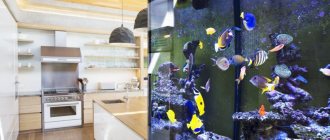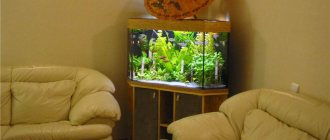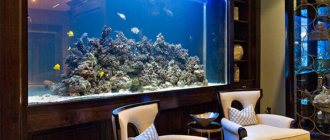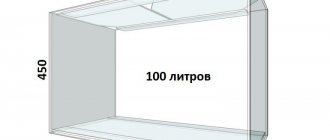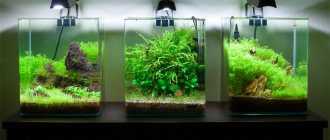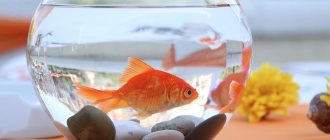Choosing a location for the aquarium
The very first and most important thing to think about is where to put the aquarium. All other points will depend on the chosen location. For example, the size and shape of the tank. A dark and quiet part of the room is ideal. It is important to consider the following:
- Temperature conditions. The reservoir should be placed away from heating areas - radiators and pipes. Overheating of water can cause discomfort for fish, so this factor should be excluded.
- Lighting. It would be a mistake to install an aquarium near a window, because... exposure to bright direct sunlight will cause the water in the tank to “bloom”. To eliminate unnecessary hassle with maintenance, place it along the wall, opposite the window or perpendicular to the window. This way the light will only fall on the side and front walls.
- Electricity. The presence of sockets nearby is necessary, because... After installation, you will need to connect many devices - lighting lamps, filter, compressor, heater. Consider where you will connect the equipment.
The tank must be placed on a solid foundation. A special stand would be an excellent option. This device is made of a material that is resistant to moisture and high loads, because the weight of one liter of water is approximately 1 kilogram. Quite often, stands are represented by cabinets with spacious compartments. They are mainly made from chipboard and MDF. The boxes can be used to accommodate all the necessary equipment that is used for the proper maintenance and care of the inhabitants of the aquarium.
Do not install an artificial pond near sources of electromagnetic fields - televisions, audio installations. Because excess vibration can harm its inhabitants.
Do not forget to take into account that an aquarium is a fairly noisy installation, so if you want to place it close to your sleeping area, purchase equipment with a low noise level.
Try not to miss all the above factors, and your aquarium, along with its inhabitants, will delight you for a long time.
Photo of aquarium design with live aquarium plants
Amanovsky, Dutch aquariums The advanced and most popular trend in the design and decoration of aquariums is the creation of a herbalist. The main characteristic of such aquariums is the idea of naturalness. When creating such aquariums, only natural and “live” decorations are used. The ideological inspirer of this trend is the Japanese aquarist Takashi Amano, you can familiarize yourself with his works HERE . A number of his works will also be presented below.
Which aquarium is better: glass, acrylic or plastic?
Aquariums are made of glass, acrylic or plastic. Each of these materials has its own pros and cons.
— Glass is easier to clean, because... When washing, do not be afraid of scratches. However, such a surface can change the acidity level of water by reacting with it.
— Plastic is safer for both aquarium inhabitants and their breeders. But the plastic surface quickly loses its original appearance and fails.
— Acrylic (plexiglass) containers are more expensive than glass ones. At the same time, they are stronger, lighter, and the water in them cools more slowly than in glass tanks.
The role of the materials from which the aquarium is created
Until quite recently, an aquarium could not be imagined without metal stiffeners installed in the corners. The development of technology and the creation of special adhesives with a high degree of adhesion have made it possible to offer aquarists vessels made exclusively from transparent materials. With appropriate lighting, such aquariums give the fantastic impression of a cube of water with fish frozen in space.
Such materials are usually glass – silicate and acrylic. Each of them has its own advantages and at the same time disadvantages.
Aquariums made of silicate glass are much heavier. In addition, there is a danger of water immediately pouring out in case of damage. When installing, it is necessary to pay great attention to the strictly horizontal position of the bottom - otherwise, over time, due to the development of glass aging processes, the bottom may burst and a flood will form in the apartment. At the same time, such aquariums are easier to maintain - since when cleaning from growing algae, the surface of the glass walls is practically not scratched, the walls of the aquarium retain their transparency for a very long time.
Aquariums made of acrylic glass are very durable and at the same time do not have much weight. In acrylic, the processes of material fatigue develop more slowly (do not forget that a column of water is constantly pressing on the surface of the walls and bottom). During installation, you may not carefully monitor the strict horizontality of the bottom. The disadvantages include the requirement to use only special products and sponges when cleaning the internal surfaces of the aquarium. Otherwise, the drainage will quickly become covered with micro-scratches and become cloudy.
If you plan to keep schooling fish, remember that they need space to constantly move. The length of aquariums for such fish must correspond to at least the minimum width-to-length ratio - 1:3. If you intend to keep fish with a tall body, for example, an angelfish, you need to ensure that the height of the aquarium fits at least three sizes of the body height of the fish.
Corner aquariums
This type of aquarium is quite common. They are suitable for placement in a corner, which makes it possible to rationally use the limited space available. This solution is relevant for both offices and small apartments, where every centimeter of space counts.
An important feature of corner models is the large area of the glass part. This increases the aesthetics of the decorative pond. The play of glare of light, bizarre refractions - all this is truly mesmerizing. In the water column you can create an unusual composition consisting of plants and corals. Wide design possibilities make the aquarium an important interior component, and in some cases, one of the lighting elements.
The main differences between marine aquariums are based on the type of aquatic organisms they contain.
Based on the type of hydrobionts they contain, marine aquariums are usually divided into fish and reef aquariums. Moreover, this division is relatively conditional. Just as a fish aquarium designed for fish can contain certain types of reef invertebrates, a reef aquarium can contain fish that are compatible with invertebrates. For example, the beautiful fish African lionfish (Pterois mombasae) can get along well in a reef aquarium with corals, provided that it does not contain ornamental shrimp and other crustaceans that can become its prey.
Panoramic aquariums
A distinctive feature of this type of aquarium is the presence of a curved front glass, which improves visibility. By configuration, aquariums can be round, rectangular, or corner. The specific design of the panoramic wall allows you to view every detail of the underwater composition in an enlarged form. Such aquariums look especially beautiful in spacious rooms.
"Hard reef with large-poly corals"
Large polyp stony corals, or LPS corals, have large polyps on their calcareous skeleton. The appearance and shape of the coral is given by large open polyps, which almost completely cover the skeleton. LPS corals, in general, do not require such intense lighting and strong currents as small polyp stony corals, and in terms of maintenance complexity they are somewhere between Alcyonaria and small polyp (SPS) corals. This explains the advisability of keeping them in a separate reef aquarium. The most popular LPS corals in marine aquariums include the following: Galaxea sp., Caulastrea sp., Lobofillia, Tubastraea sp., Euphyllia sp.
Wall models
Aquariums of this type appeared relatively recently. For a long time, professionals were skeptical about the installation of such containers. This was due to the fact that wall-mounted models are always very narrow. Caring for them is quite difficult, and not all types of fish can be kept in such conditions.
Over time, manufacturers have improved wall-mounted aquariums, and they are now a very common way to create a blue lagoon indoors. Externally, the tank resembles a painting; frames are often used for framing. The issue of caring for the inhabitants of the aquarium has also been resolved. As a rule, such models are equipped with complex control systems using computer technology. Wall aquariums are a unique combination of innovation and aesthetics.
Who should populate a species aquarium?
The main difference between a species aquarium and a decorative one is the observation of a certain number of two or three species of fish or fish of the same genus. In this way, the owner can easily observe the behavior of the fish, their relationships or reproduction. There are certain types of fish that cannot get along with other types of fish. It is easier to observe them when isolated from the rest of the underwater community. For example, fish are predators. If fish species can coexist peacefully, it is acceptable to stock 2-3 species of fish. For example, schooling fish. It is worth carefully consulting with a specialist who will tell you which species show aggression towards each other and which coexist peacefully. It is important to understand that all fish show aggression. Even peaceful and innocent guppies. Intraspecific aggression is normal. Therefore, when choosing fish for a species aquarium, it is worth clarifying which species get along well with other types of fish. And what kind of fish are gloomy loners, incapable of being neighbors?
Rectangular aquariums
This option is a classic of the aquarium genre. When choosing an aquarium for beginners, you simply cannot find a better rectangular model. Its main advantages include:
- versatility - such containers are suitable for breeding any fish and plants;
- effective enrichment of water with oxygen - if the height and width parameters are approximately the same, then oxygen will be evenly distributed throughout the entire water space;
- convenience for fish - the rectangular design allows all inhabitants of the decorative pond to move freely;
- wide decorative possibilities - in aquariums of this shape you can create compositions of any complexity, from classic to fantasy;
- accessibility - rectangular models, as a rule, are inexpensive; they best maintain a balance of price and quality characteristics.
If you plan to place bottom-dwelling fish (for example, catfish, stingrays) in an aquarium, it is better to choose an aquarium with a large bottom area. For inhabitants that prefer to stay in the middle and upper layers of the water column (angelfish, discus), you need to buy a deep container.
How much will it cost?
We have calculated for you the approximate cost of purchasing a new freshwater aquarium with a volume of 100 liters without fish and live algae; this calculation is valid at the end of 2021.
| Name | Quantity | Price |
| Aquaplus STD P-100 (70*30*50) aquarium with lamp, pear color, STD2*18W | 1 PC. | RUB 5,107 |
| Aquael stand straight for AluDekor 80, black | 1 PC. | RUB 5,258 |
| AquaEL ASAP 500 - Internal filter for aquariums with a volume of 50-150 l. 500 l/h | 1 PC. | 865 rub. |
| AquaEl Oxyboost AP-100 plus - compressor for aquarium | 1 PC. | 555 rub. |
| Zolux Aquasand Mix Havaii 9 l - Soil for aquarium 'Hawaiian Mix' | 2 pcs. | RUB 3,228 |
| AquaEl Easy Heater 100 W - thermostat for aquariums up to 100 liters | 1 PC. | RUB 1,235 |
The final approximate cost of purchasing a new freshwater aquarium with a volume of 100 liters at the end of 2021 will be 16,248 rubles
.
Classification of aquariums
Shape is not the only parameter that needs to be taken into account when choosing a good aquarium for keeping fish. The classification of such containers will help you decide. Note that it is quite conditional and is based on the established practice of using home aquariums. To understand which aquarium is better to choose, it is important to decide for what purpose you are getting fish.
Aquariums are classified as follows:
1. According to the characteristics of the water poured into the tank
- tanks can be freshwater or marine, and there is also a transitional type - brackish water aquariums. Salt water aquariums are much more difficult to maintain than fresh water aquariums because changing the water in them requires sophisticated natural regeneration equipment and cleaning devices. Marine aquariums are characterized by the presence of a strong current, so you need to take care of installing powerful pumps that can create an imitation of it.
2. By temperature
- Aquariums can be warm or cold water. The choice of such an aquarium depends on what kind of fish you plan to keep.
3. According to the specifics of execution
- The tanks are represented by deep and shallow water models. The former are characterized by greater depth, the latter by an increased bottom surface area.
4. By volume
- Aquariums, depending on their size, are divided into small-sized (20-100 l), medium-sized (100-250 l), high-volume (250-550 l), giant (550 l and more).
5. According to the characteristics of the inhabitants
- containers can be general - intended for different types of fish, collection - in which certain inhabitants and plants are collected, and biotope (when filling, the geographical principle is taken as a basis).
6. By appointment
- spawning models. In such aquariums, favorable conditions are created for the reproduction of fish;
- growing models. Used for raising fry that are transferred from the spawning aquarium;
- quarantine models. These types of aquariums are needed to keep only purchased fish before transplanting them into a general aquarium. It is possible to use such containers for temporary isolation and treatment of aquatic inhabitants;
- cultivation tanks. The tanks are designed for growing live food for fish - ciliates, daphnia, hamarus, and algae.
It is imperative to take into account the classification of containers. Ignoring the conditions of keeping fish will lead to biological imbalance. As a result, the water will become cloudy, and this will negatively affect the condition of the inhabitants and plants.
You need to approach the purchase comprehensively. Most mistakes when choosing an aquarium are made at this stage. Be sure to remember the need to select suitable accessories - stand, compressor and filtering equipment, lamps to create optimal lighting, etc.
If you still want to start an aquarium, here are some basic recommendations
- Decide on the type of aquarium and where you will put it. The aquarium should always stand strictly level.
- The larger the aquarium, the easier it will be to maintain, and it is better not to consider small aquariums of 3-5 liters at all: these are storage rooms for fish.
- Before starting for the first time, be sure to prepare the aquarium for two weeks. Fish cannot be placed in an unprepared aquarium.
- Overpopulation and overfeeding of fish are the worst enemies of the aquarist. Fish exist in a confined space: they ate more, which means they left more waste products. The more fish, the more waste.
- Equipment - a filter, a lamp, a thermostat, a thermometer and a compressor - is a prerequisite for the existence of an aquarium; without it, the fish will suffer.
- Each aquarium should have an individual set of tools: this is hygiene.
- If you like to leave home for a long time and want to get a pet, fish are a good choice: they can be safely left alone if you use timers and automatic feeders.
NEW RED SEA MAX NANO AQUARIUM AND NEW ADDITION TO V2ILUMENAIR TMC LIGHTING RANGE
A SMALL AQUARIUM AND EVERYTHING YOU NEED TO KNOW ABOUT IT.
LARGE AQUARIUM FOR HOME - LAUNCH DESIGN EQUIPMENT PHOTO VIDEO.
MARINE AQUARIUM - LAUNCH PROPERLY PHOTO VIDEO STEP-BY-STEP DESCRIPTION.
Main types of aquarium accessories
Now you can move on to studying the accessories that are necessary to equip a decorative pond. Let us dwell in more detail on the devices that you simply cannot do without when arranging a tank.
Heater
Maintaining optimal water temperature is an important task. Sharp changes in indicators negatively affect the condition of the inhabitants of the artificial decorative pond and plants. On average, the temperature in the aquarium ranges from 22 to 32 degrees, specific indicators depend on the type of fish contained in it.
Until recently, the choice of aquarium heaters was small. Buyers were offered standard models. They are still available in specialized stores, but modern heaters with thermostats are becoming increasingly popular.
The choice of equipment power depends on how large a capacity you use to create a corner of residential nature in your home or office. It is desirable that the indicator be about 1.5 W per 1 liter of water. So, if you have a 100 liter aquarium, the heater power should be approximately 150 watts.
In addition, you need to understand that the temperature of the water in the aquarium is influenced by the characteristics of the environment. Considering the fact that the heating may be turned off unexpectedly, you need to buy a heater with a power reserve. This will make it possible to avoid excessive cooling of the water.
High-quality water heating equipment means reliability, energy efficiency, and durability. You should not purchase cheap handicraft models, because if the temperature rises or falls, the inhabitants of your artificial reservoir may simply die. Choose aquarium equipment from trusted brands. In addition, it is worth considering using two medium-power heaters. In this case, if one device breaks down, the other will be able to maintain relatively normal conditions for fish, snails, and plants.
Compressor
Compressor equipment in an aquarium is a must. Its main task is to saturate the water with oxygen, which is necessary for the proper functioning of the ecosystem. In addition, compressors are used to operate bottom and airlift type filters.
Devices may have different technical characteristics. You need to select a suitable model taking into account the volume of the aquarium: the larger it is, the more powerful the compressor is needed. Signs of quality products are:
- performance;
- energy efficiency;
- low noise level during operation;
- aesthetics and neatness of execution.
Lamps for lighting system
In order to properly organize lighting in an aquarium, it is necessary to carry out a series of calculations and get an idea of the specifics of different types of devices. Most often, the selection is based on product parameters such as:
- device power (optimal indicator - 1 W per 1 cm of container length);
- light intensity (should be from 30 to 50 lumens per 1 l);
- bottom area (0.7 W per 1 dm2);
- total volume of the aquarium (0.5 W per 1 l).
Also, when purchasing lamps, you need to take into account not only their power, but also the color spectrum that they emit. This is important for the proper growth of living aquarium vegetation, which is very demanding on the light spectrum.
Don't forget about installing reflectors. Their presence will make it possible to effectively control the light flux and reduce energy losses. Which, without a reflector, will be distributed not only to water.
Filters
Water purification systems are divided into two large groups - internal and external. The latter are more efficient, but are not suitable for use in compact aquariums due to their high power.
High-quality filters are quite complex devices that provide several degrees of water purification. Their fillers include sponges and activated carbon for mechanical filtration. Biological treatment is carried out by using ceramic rings or granules.
When choosing devices, you need to pay attention to the following:
- number of cleaning blocks;
- productivity indicator (l/hour);
- quiet operation of the filter;
- energy efficiency level;
- aesthetics and neatness of execution.
How to buy a device with the desired performance indicator? It should exceed the volume of the aquarium by approximately 3-4 times. Thus, for a 100 l aquarium you need a filter of 300-400 l/hour.
Feeders
These accessories are special containers that contain fish food. Depending on the design features, such products can be conventional or automatic. Most often they float on the surface of the water or attach to glass using a suction cup.
It is better to use automatic devices. You can set the frequency of feed delivery. As a rule, it is enough for fish to receive food 2 times a day; sometimes it is worth organizing fasting days, switching to one feeding.
The source of energy in automatic feeders is batteries. If you plan to leave for a long time and leave the fish without your attention, the system will take care of the nutrition of the inhabitants of the aquarium. The main thing is to check the condition of the batteries.
Aquarium soil
Choosing soil for an aquarium is an important point in arranging an aquarium. So, if you plan to keep small fish, you should not use sand, because they will bury themselves in it, which will lead to cloudiness of the water. Study the characteristics of the inhabitants of your aquarium, and then make a choice.
It is even more important to buy the right soil for normal plant growth. The thicker the bedding layer, the better the plants will be able to take root. The recommended value is 5 cm. To improve the quality of the substrate, you can add peat and other components for enrichment.
Remember that the most natural soil possible is best suited for an aquarium. Avoid buying formulations that contain many different chemicals.
Tritons
If the axolotl is too large for you, but you want to keep something other than fish, then newts are suitable. For some species, an aquarium is enough, without access to land. It is important not to confuse who can be kept in an aquarium and who can only be kept in an aquaterrarium. Therefore, I will list the most popular species, for starters, those that live in an aquarium without problems.
Common newt
The most famous and widespread is the common newt. Even if you live in Moscow or the Moscow region, you could have met him. It lives in shallow standing waters, its maximum size is up to 10 cm, more than half of which is in the tail. The back is brownish-brown, the belly is yellow or orange, the male is slightly larger than the female.
Spine newt
Spiny newt in an aquarium at the Aqua Logo salon
The spiny newt is an inhabitant of the Pyrenees and Morocco - despite the fact that it can go onto land, it prefers to live without leaving the reservoir. This is a very large newt, up to 30 cm in length and has outgrowths of ribs with poisonous glands, however, this is not dangerous for humans if you are not going to eat it alive. Its color is dark brown with darker spots, its abdomen is light, a stripe of orange spots runs along its body, and its tail is short, compared to other newts.
Fire-bellied newt
Fire-bellied newts are native to Japan and are perhaps the most ornamental. Their back is dark gray, almost black, their belly is red in males and bright orange in females. Size up to 15 cm. In addition to its bright appearance, this newt is also the most active and interesting to observe.
A few words about those newts that are best kept in an aquaterrarium.
Crested newt
This is a crested newt, reaches 18 cm in length, during spawning the male develops a characteristic crest on his back, during the breeding season they live in water, and the rest of the time they prefer to live in the damp forest floor, that is, they lead a terrestrial lifestyle. Their color is dark brown with darker large spots, the abdomen is yellow or orange.
Spanish newt
The Spanish newt is endemic to the Iberian Peninsula and lives outside the breeding season on moist soils near water bodies or even on dry slopes. Reaches 10 cm in length. Body color ranges from dark olive to yellowish, belly color ranges from orange to pinkish. When living on land, the skin is denser and rougher; in water it becomes smooth.
Chinese red-bellied newt
The dwarf or Chinese newt, also called the red-bellied newt, is widespread in China and is one of the smallest species of newts, up to 8 cm in length. Its color from the back is inconspicuous - dark gray, and its abdomen is bright, red-orange.
Newts are kept in aquariums with a volume of 20 liters or more (for small species). But it’s better to take a larger aquarium. It is important to have a tight lid or cover glass to prevent the newt from escaping, which could lead to its death. The choice of substrate has something in common with the same process for axolotls. Newts can also swallow soil at risk to their lives, so it must be either very small or very large. Newts are quite shy, with the possible exception of the Japanese one, but in any case, shelters made from coconut shells and driftwood are necessary for them. This is also a place of shelter. And a resting place for newts.
Live plants in an aquarium with newts are extremely desirable, one might even say necessary. They not only serve as shelter and substrate for spawning, but also form a microclimate most suitable for these animals. The composition of the aquarium flora depends solely on your choice and the power of the aquarium lamp. Newts can rest on broad-leaved plants such as anubias and echinodorus, and they find excellent shelter in thickets of rotal, ludwigia and hornwort.
Anubias Bartera on a driftwood Ludwigia “Super Red” Hornwort dark green Anubias Bartera “Little” Anubias Bartera Broadleaf in a pot
Echinodorus Blechera
Newts are not fans of strong currents and, if cleaned in a timely manner, live well in an aquarium without additional filtration, but in this case one should not forget about weekly water changes.
In general, caring for an aquarium with newts is no different from caring for an aquarium with axolotls. The water temperature for newts should be no higher than 22 degrees Celsius, this is especially important in the summer, otherwise the newts become inactive and may even die. Water hardness does not play a special role and can be average, in the range of 6 -16 German degrees, pH in the range of 7 - 7.5. The skin of newts is not as delicate as that of axolotls, but you should not pick them up, our body is too warm for them and even a thermal burn is possible.
Newts molt from time to time, so you don’t have to worry about cleaning up the moult skin - newts eat it without leaving a trace.
As for the neighbors for the newt, if the newts are large and the aquarium capacity exceeds 100 liters, then goldfish will do, but in this case you will have to worry about the delicate aquarium flora - it will be eaten. If the newts are not large, the aquarium for them is about 50 liters; common danios, cardinals and guppies are suitable as neighbors, whose fry will serve as a pleasant addition to the newts’ diet.
Feeding newts is no different from feeding axolotls; their diets are similar and differ only in the fraction of food, since newts are usually smaller than axolotls.
And in terms of life expectancy, newts have overtaken axolotls - they can live up to 20 years!
© Aqua Logo Alexandra Chebotaev
You can read about another interesting inhabitant of the aquarium in the article “The clawed frog in the aquarium.”
*Some of the animals mentioned in the article may be on the verge of extinction in the wild; they are described in the material for information only and are not recommended for home keeping.
**We do not hunt animals or remove them from the natural environment. The photo shows domestically bred animals kept in captivity. The rules for keeping them in captivity are established by Federal Law No. 498-FZ of December 27, 2018 “On the responsible treatment of animals and on amendments to certain legislative acts of the Russian Federation.”
Fields marked with * are required.
Which aquarium to choose?
When choosing, pay attention to the following points:
- the condition of the glass - it must be smooth, without chips or cracks, because even minor damage may not withstand the pressure of water on the walls;
- features of the seams - pay attention to their evenness, traces of sealant - a sign of low quality products;
- processing of the ends - they must be polished, this eliminates the possibility of injury and the presence of microcracks that appeared when cutting glass;
- the presence of stiffening ribs - they are mandatory in aquariums whose length is more than 0.5 m; the parts are glass strips perpendicularly attached to the walls of the tank.
"Hard Reef"
The Hard Reef is composed primarily of hard corals. They are also called Madreporaria or Scleractinia and belong to the order of coral polyps from the subclass of six-rayed corals (Hexacorallia). Unlike Alcyonaria, Scleractinia form a hard calcareous skeleton.
A stony coral aquarium can be stocked with other invertebrates and contain certain species of fish that are compatible with stony corals. The division of a reef aquarium into “Soft Reef” and “Hard Reef” is associated, first of all, with the unequal conditions of their maintenance. Alcyonarians are generally easier to keep than stony corals. Thus, a “Hard Reef”, in comparison with a “Soft Reef”, requires more intense light, strong currents, and higher water quality. In addition, it must be taken into account that both Alcyonaria and hard corals can use toxins as weapons of attack and defense. In stony corals, these are nematocyst stinging cells, with the help of which the coral hunts for planktonic organisms and fights for habitat with neighboring corals. Alcyonaria secrete chemical compounds of varying levels of toxicity for protection and control. Those. between corals so-called "chemical wars" for survival. Therefore, when Alcyonaria and hard corals are kept together, a conflict may arise and one species may be suppressed by the other.
In turn, “Hard Reef” can be divided into “Hard Reef with Large Polyp Corals” and “Hard Reef with Small Polyp Corals”.
"Hard reef with small-poly corals"
Small polyp stony corals or SPS corals have small polyps on their calcareous skeleton. The skeleton is the basis of the shape and appearance of the coral, since the opened polyps are small in size and adorn only the surface of the formed skeleton, without changing its shape.
SPS corals can create numerous colonies of the most varied shapes and colors. Corals have an attractive appearance, but are very demanding in terms of maintenance conditions. It is necessary to maintain high water quality, provide intense lighting of a certain spectrum and create powerful water flows. SPS corals are more difficult to maintain than LPS corals, so a separate “Hard reef with small polyp corals” is desirable for them . Preferably kept by experienced aquarists. The most popular SPS corals in marine aquariums include the following: Acropora sp., Montipora sp., Pocillopora sp., Seriatopora sp.
According to water composition
According to the characteristics of the water and habitat, aquariums can be marine, freshwater, pseudo-marine or brackish water. The set of necessary tools for such aquariums includes various devices that ensure the maintenance of the required water parameters and the correct microclimate.
- Freshwater aquariums are widely used and contain freshwater types of fish and plants. Maintenance of these aquariums is much easier than that of marine aquariums. They can be of various shapes and sizes and fit perfectly into the interior.
- Marine - intended for the habitat of plants and fish accustomed to salt water conditions. Aquariums are large in size, since marine fish are large in size. They are quite difficult to maintain and require the necessary skills to create the correct chemical composition of water.
- Brackish water is an intermediate type of aquarium that serves as a habitat for fish and plants in desalinated zones of estuaries and bays that can live in brackish waters. These subtropical inhabitants have managed to adapt well to changes in temperature, and can live in both cold and warm water.
Return to content
